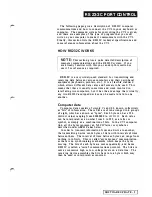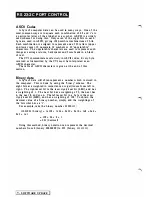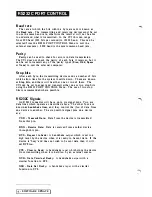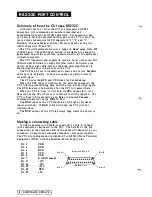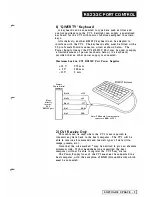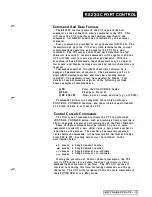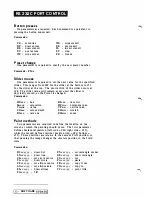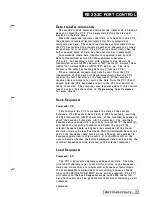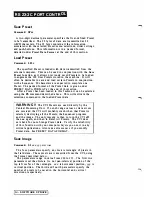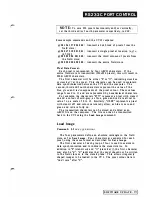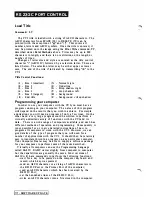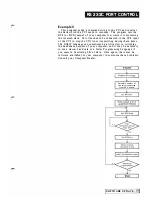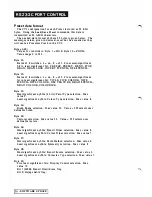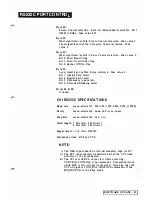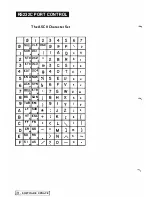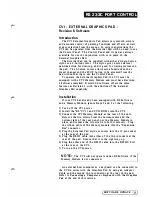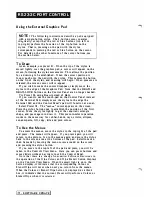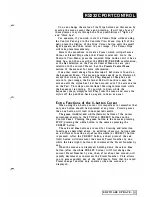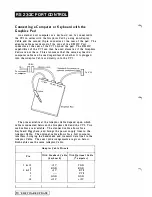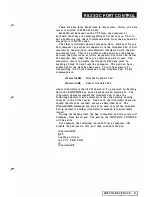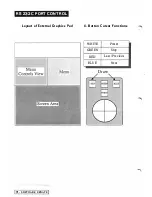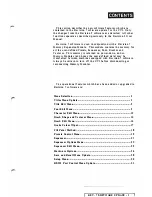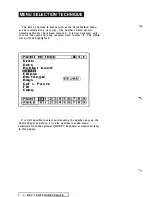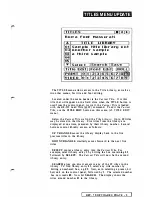
R S 2 3 2 C PO RT CO N T R O L
Load Title
Command: LT
The CVI title is loaded with a string of ASCII characters. The
ASCII characters from SPACE (20) to DELETE (7F) can be
printed (with the exception of
"@"
and
"\").
This covers all
numbers, letters and ASCII symbols. Once the title is entered, i t
m a y be printed onto t h e image using the
Print Title
command,
TT,
described under
Paint Methods
above. Titles may be up to 600
characters in length, and there is no restriction on the length or
number of lines.
Changes of letter size and style are entered as the title control
character
"\"
(ASCII 5C) followed by a selection letter. These are
listed below. The selection letter may be either upper or lower
case. The end of the title is indicated by transmi tting
"\E"
to the
CVI.
Title Control Functions:
\ 1
- Size
I
(smallest)
\2
- Size 2
\3
- Size 3
\4
- Size
4
\S
- Size 5 (largest)
\E
- End title
\N
- Normal style
\U
- Underline
\8
- Drop shadow right
\
T
- drop shadow left
\B
- background
\C - background
+
drop shadow
Progra mming your computer
In order to use your computer with the CVI you must have a
program running on your computer. The nature of this program
will depend on the results that you wish to achieve. For simple
applications you will need a program of only a few lines. On the
other hand a very large program could be written to perform a
virtually unlimited variety of functions with the CVI and its
data. There is a wide range of computers available, and each has
different methods of operation and programming. Consequently it
is not possible for us to give detailed instructions of how to
program all computers to work with the CVI. However, we can
give details of the
type
of program that you will need for a
number of appl ications with the CVI. It should then be relatively
easy to translate this into a program on any particular compu ter.
Your Computer Dealer may be able to supply a software package
for your computer to perform some of the tasks described.
Virtually all computers can use the Programming Language
called BASIC. BASIC varies slightly from computer to computer
but the capabilities are generally the same. Most versions of
BASIC will have commands to perform the following func tions:
- wait for a key to be pressed on the compu ter keyboard and
record which key was pressed;
- send an ASCII character or a string of ASCII characters to
the RS232C Port or the Printer Port of the computer;
- read an ASCII character which has been received by the
RS232C Port;
- set the handshake lines of the RS232C Port;
- write an ASCII character into a file stored in the computer.
-
SOFTWARE UPDATE
",--. "
Содержание CVI
Страница 1: ...r e User Manual Computer Video Instrument...
Страница 4: ...Startea 2 Video Melius...
Страница 102: ...33 Quad mirror Slow scan across L J _J...
Страница 103: ......
Страница 104: ...56 Under over stencil 57 Under over catch up 58 Push to freeze...
Страница 105: ...60 L J _JI L...
Страница 106: ...80 Under over texture wipe L J _J...
Страница 107: ...L J _Jd r...
Страница 137: ...SYM M ETRY M E N U 8 Spin 1 80 degree rotation around the current screen centre giving two images PAINT MENU 27 I...
Страница 196: ...lilli an _ _ _ _ _ _ _ _ _ _ _ _ _ _ _ _1l _ b h _ _ _ _ _ __ _ _ _ _ _ _ _ _ 9 b_ _ __ QUICK SELECTION VIDEO MENU...
Страница 197: ...RS232C Port ControI 1 Rev 7 Software Update 1...
Страница 268: ...Glossary 1 Index 5...
Страница 282: ......


